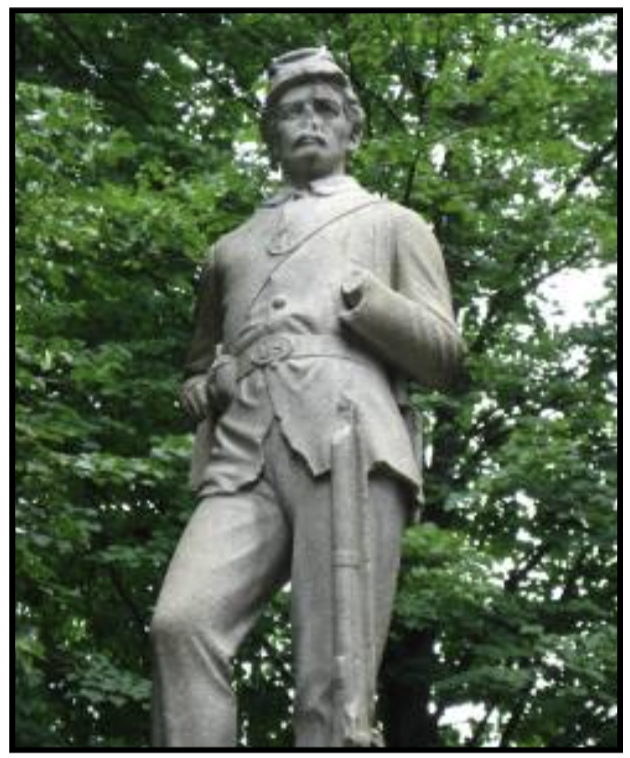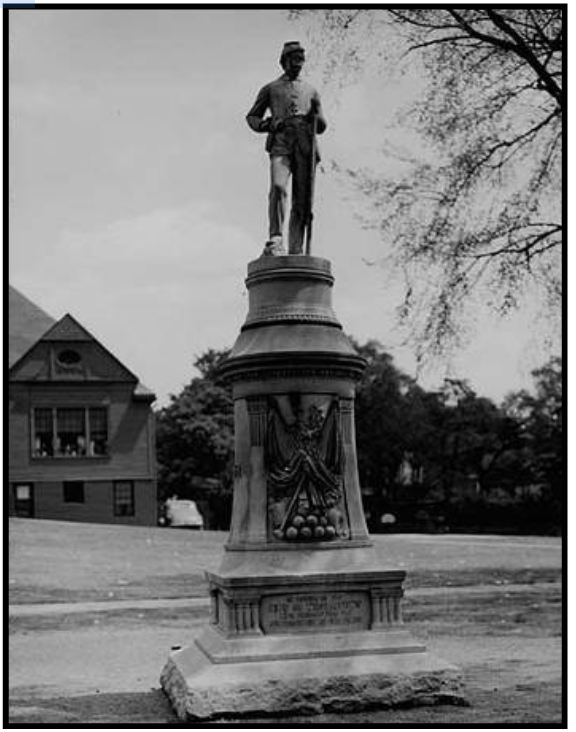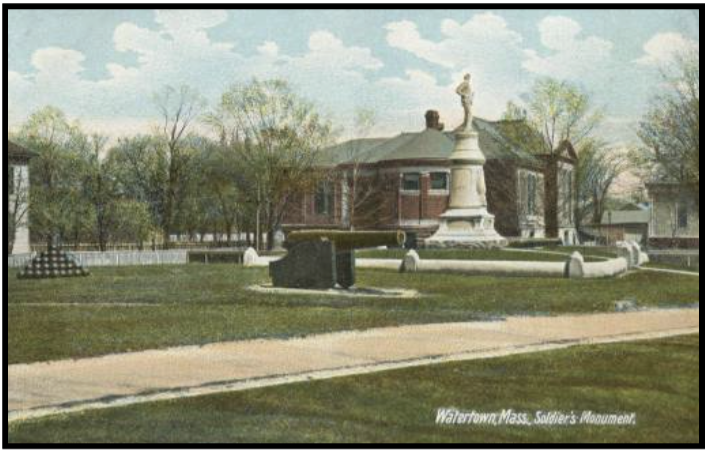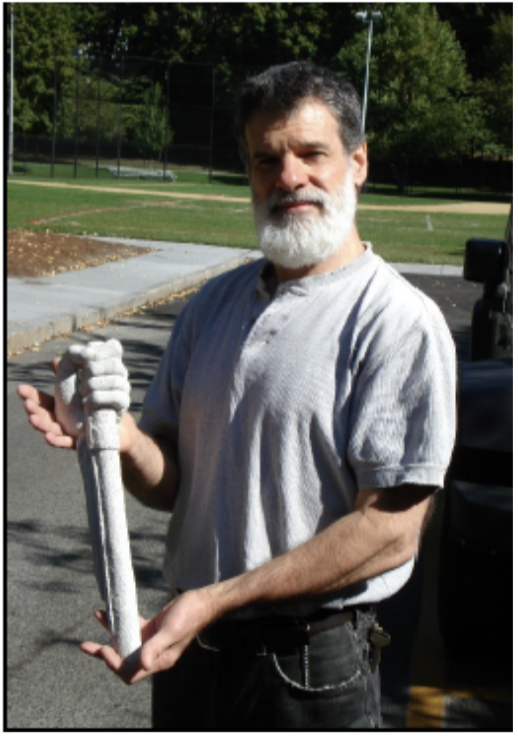
The following story is part of a series on local history provided by the Historical Society of Watertown. It was written by Jon Spector, a former Board member of the Historical Society of Watertown for the January 2014 Historical Society newsletter, “The Town Crier.”
We are pleased to report that the historic Civil War Soldiers’ Monument in Saltonstall Park has at last been restored. Historical Society of Watertown Council Member Jon Spector was the Chair of this project.
This statue stood in disrepair for decades and would have remained so if Jon had not taken the initiative to get it restored. His diligence in getting the word out, raising the funds, writing the newsletter to keep people updated on the progress and pursuing the grant in conjunction with the town was a lot of work. His dedication to the restoration of this monument is evident. What a transformation! This is an effort that will be seen by the Watertown community for years to come.
The restoration work was coordinated by Daedalus, Inc, of Watertown, conservators of monuments, architectural ornament, grave markers, sculpture and fine art. The first step in the restoration, stated Joshua Crane of Daedalus, “is to gently power-wash the surfaces of the monument.” The result of this cleaning that begun on August 1, 2013 was that the intricate veining of the granite was visible for the first time in decades.
Then the actual restoration of all the joints and surfaces began. After that, the artisan work began for the replacement of the soldier’s cap, rifle, nose, hand and other chips on the monument’s surfaces. The artisan work was done by Watertown sculptor David LaRocca. Mr. LaRocca has walked by the damaged statue for many years and wished to see it restored to its original state, and to help restore it. He was delighted when asked to be involved.
Jon submitted the following article on the rededication ceremony:
On November 11, 2013, the Soldiers’ Monument in Saltonstall Plaza was rededicated. Over 200 people, along with State and Town officials, joined in on the celebration. With excellent weather, the event was both a celebration of the restoration of the statue and a solemn observance of Veterans’ Day. Honor Guards from local Veteran’s organizations, Revolutionary re-enactors, the Police department and the Fire department were in attendance.
The Historical Society of Watertown had worked closely with the Town planning the much- needed statue restoration and plaza area renovation. Over the past 18 months, the Society had conducted a fundraising campaign for the necessary work. Generous contributions were raised from local residents, several banks and businesses, and a State grant from the Civil War Sesquicentennial Commission, which supports projects on this 150th anniversary of the Civil War.
As part of the rededication, several proclamations were presented. Marilyn Pettito Devaney presented a proclamation from the Governors’ Council and Town Council President Mark Sideris announced the Town’s recognition of the importance of this event. The Gettysburg Address by Abraham Lincoln was read by Yasmina Spector, followed by remarks from Ms. Devaney, Mr. Sideris, and Steve Magoon of Community Development and Planning. Captain Wilfred Clifford, USMC (Retired), a local resident, gave a moving tribute to the Soldiers’ Monument. Watertown High School recently held an essay contest as part of an outreach project by the Historical Society. After dozens of entries, the winning essay was selected. Ashley Smith, a senior at the High School, read her composition about the importance of history and how we can remember the past through such monuments.
Jon’s research on the monument drew him to search for information on the cannons in front of the statue and of Saltonstall Plaza itself. In the proposals he wrote for fundraising purposes, he recounted some of the facts he had uncovered, including the following:
The Soldiers’ Monument:In the Spring of 1881, it was noted during a Memorial Day address by Rev. E.P. Wilson that it would be desirable to construct a monument to those from Watertown who “so freely and honorably served Watertown” during the Civil War. A committee was appointed in June 1881 by the Watertown GAR (Grand Army of the Republic) Isaac B. Patten Post #81 to develop the plan for the park by involving “leading citizens”. The process resulted in the Town Council appropriating $3,600 ($75,000 in 2010 dollars) in March 1889. With impressive speed, the monument was completed over the course of five months.

The dedication took place on October 31, 1889 and was a “gala day” with local residents gathering “in great numbers” to celebrate. “Business was suspended, the schools closed, the Town Hall and other public buildings were gaily decorated with pictures, flags and bunting.” Over 350 people attended the ceremonies, with many members of local Posts, government officials and workers, local leaders and fraternal organizations taking part.
In the Watertown Enterprise of November 1, 1889, it was reported: “The entire structure is a handsome tribute to the memory of those who fought in the war. It is an object of general compliment and commendation, and is a most satisfactory piece of work to the citizens of the town.
It stands in a very conspicuous position where it can be seen and admired by all who pass through the town, and numbers have remarked that the oftener they saw the monument the more beautiful it appeared.”
According to the 1889 Town Annual Report, the statue “is a handsome tribute made by a grateful town to its heroes.”

The Statue:
The period following the Civil War had many communities installing memorials; the use of the figure of a soldier was very popular. The statue itself was fabricated at the Hallowell Granite Company of Maine, which was known for producing a number of prestigious works, including the beautiful Sphinx monument in Mount Auburn Cemetery. While the artist of the Civil War soldier is unknown, Hallowell employed a number of skilled Italian sculptors who produced such works.

The design of the statue in Saltonstall Park is, in fact, not unique. A statue with the same figure of the soldier was installed in Castine, Maine. The citizens of Castine have maintained their statue over the past century. The pristine condition of this statue will allow for an accurate restoration of the Watertown Soldiers’ Monument.

The Cannons:
The cannons located in the plot area fronting the statue have been identified as 32 pounder Navy guns of 57 hundredweight. They were made by Cyrus Alger and Co. in South Boston, MA, in 1849.
The Inspector was AAH, most probably Alexander Harwood, a naval officer. There is no
apparent record of ship service history on the pair. They are registered under numbers 520 and 521 respectively.
The Plaza:
In order to make room for the construction of the Watertown Town Hall, the statue was relocated, but remained in Saltonstall Park. In 1981, the town received a grant of $280,000 from the National Park Service under the Urban Park and Recreation Recovery project. The purpose was for the “beautification” of the park. This project included the Plaza area. The firm contracted for the design of this historic renovation was Gehry & Krueger (the renowned Frank Gehry) of Cambridge MA. The rededication of the Plaza in June, 1981 was highlighted by the words of Board of Selectmen Thomas McDermott, who said “… this beautification will forever remain a memorial to our democratic system of government and that it will be a constant reminder of the rich cultural heritage of the Town of Watertown.”
Summary:
“Lest We Forget.” This was the appeal of the Soldiers’ Monument project when the first fundraising mailing took place. The pledge to remember those fallen during the Civil War has now been affirmed. Through the diligence and financial support of the City known as the Town of Watertown, the State’s support through the State Civil War Sesquicentennial commission, the Historical Society of Watertown, significant bank and business donors, and the residents of Watertown, the Soldiers’ Monument and Saltonstall Plaza was successfully completed on November 11, 2013.

Thank you, Joyce